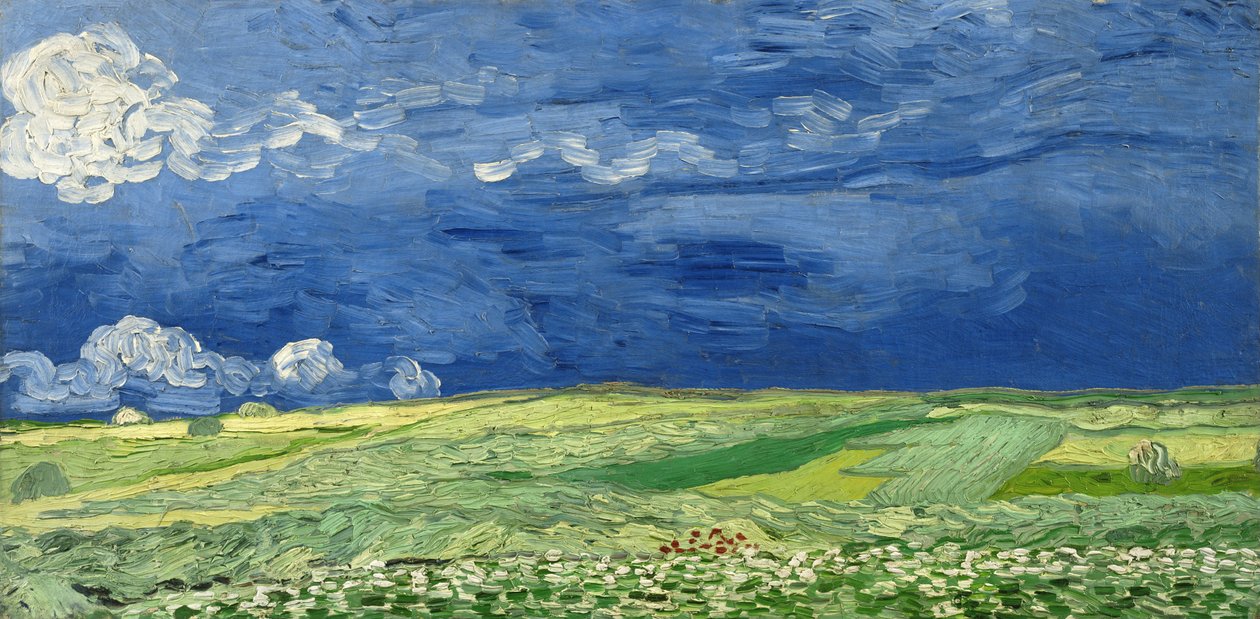Undated · Picture ID: 723568
Post Impressionism
· Famous Masterpieces
Wheat Field under Thunderclouds belongs to a cycle of paintings created by the Dutch painter Vincent van Gogh in Auvers-sur-Oise before his tragic death in 1890. He, a representative of Impressionism, obviously began a different creative period with it, which this picture in particular makes clear. On the one hand, he worked with proportions that were unusual for him, for he used an extreme landscape format. Wheat Field under Thunderclouds, which hangs in the Van Gogh Museum in Amsterdam, measures 50.9 x 101.3 cm. He used this format 13 more times during his last months. Second, it's the colors that stand out. Unlike in Arles, where the artist worked with garish and sometimes exaggerated light compositions, in Auvers he chose soft, almost mild colours. Although painted in oil, his works seem almost like watercolours. Even the brushstrokes seem more yielding, softer.
Although storm clouds hang over the wheat field, the blue hues do not seem threatening. The gently undulating wheat field alternates from a light, almost white shade of green, to a lush dark green. It's hard to think of decay at this sight. But apparently that is exactly what van Gogh had felt. For to his brother Theo in Paris he wrote: "They are endless fields of grain under dull skies, and I have not shied away from the attempt to express sadness and utter loneliness."
Surprisingly, however, the sadness he felt was not reflected in gloomy colours. Possibly, despite everything, this landscape had a consoling symbolic character for him. On the one hand, decay. Then, when the harvest is in and leaves a painful stubble field. On the other hand, the knowledge of renewal. Thunderclouds promise rain and thus growth. A recurring cycle that provides permanence. Something that was missing in the artist's life and whose disruption he expressed in a dramatic way in his paintings. In probably no other painter was it so intensely evident that he did not paint what he saw, but how he felt about things. Van Gogh not only paved the way for modern painting, but also had a great influence on the Expressionism that followed.
Wheatfield Under Thunderclouds by Vincent van Gogh. Available as an art print on canvas, photo paper, watercolor board, uncoated paper or Japanese paper.
painting ·
holland ·
landscape ·
postimpressionism ·
oil on canvas ·
gogh ·
vincent ·
van 1853-1890
· Fine Art Images/Heritage Images
Other color variations of this picture
Other color variations of this picture
|
|
×




.jpg)
.jpg)
.jpg)
.jpg)
.jpg)
.jpg)
.jpg)
.jpg)
.jpg)
.jpg)
.jpg)
.jpg)
.jpg)
.jpg)
.jpg)
.jpg)
.jpg)
.jpg)
.jpg)
.jpg)
.jpg)
.jpg)
.jpg)
.jpg)
.jpg)
.jpg)
.jpg)
.jpg)
.jpg)
.jpg)
.jpg)
.jpg)
.jpg)
.jpg)
.jpg)
.jpg)
.jpg)
.jpg)
.jpg)
.jpg)
.jpg)
.jpg)
.jpg)
.jpg)
.jpg)
.jpg)
.jpg)
.jpg)
.jpg)
.jpg)
.jpg)
.jpg)
.jpg)
.jpg)
.jpg)
.jpg)
.jpg)
.jpg)
.jpg)
.jpg)
.jpg)
.jpg)
.jpg)
.jpg)
_-_(MeisterDrucke-24407).jpg)
.jpg)
.jpg)
.jpg)
 Water-Lilies - (MeisterDrucke-21577).jpg)
.jpg)
.jpg)
.jpg)
.jpg)
.jpg)
.jpg)
.jpg)







